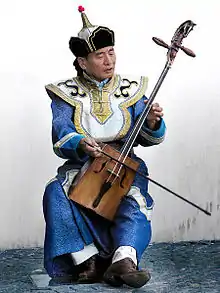Bowed string instrument
Bowed string instruments are a subcategory of string instruments that are played by a bow rubbing the strings. The bow rubbing the string causes vibration which the instrument emits as sound.
| Part of a series on |
| Musical instruments |
|---|
Despite the numerous specialist studies devoted to the origin of the bowing the problem of the origin of the bowing is unresolved [1]
Some say that the bow was introduced to Europe from the Middle East [2][3][4] while others say the bow was not introduced from the Middle East, but the other way round, that that the bow may have had its origin from a more frequent intercourse with North Europe and Western Europe [5] [6]
List of bowed string instruments
Violin family

Niccolò Paganini playing the violin, by Georg Friedrich Kersting (1785–1847)
- Pochette
- Violin (violino)
- Viola (altviol, bratsche)
- Cello (violoncello)
- Double bass (contrabasso)
- Variants on the standard members of the violin family include
Viol family (Viola da Gamba family)

Karl Friedrich Abel playing the bass Viola da Gamba, by Thomas Gainsborough (1727–1788)
- Treble viol (treble viola da gamba)
- Alto viol (alto viola da gamba)
- Tenor viol (tenor viola da gamba)
- Bass viol (bass viola da gamba)
- Variants on the standard four members of the viol family include:
- Pardessus de viol
- Division viol
- Lyra viol
- Baryton
- Violone
- Viola d'amore
- Lirone
- Vihuela de arco
Lyra and rebec type
Chinese bowed instruments

Two performers playing the Erhu, sometimes known as the Chinese fiddle.
Rosined wheel instruments

A performer playing the Morin Khuur, the Mongolian Horse Fiddle
The following instruments are sounded by means of a turning wheel that acts as the bow.
Other bowed instruments
- Masenqo
- Violoncello da spalla
- Ravanahatha
- Ajaeng
- Yaylı tambur
- Kingri string Instrument
- Shichepshin
- Đàn nhị
- Đàn hồ
- Đàn gáo
- Sohaegeum
- Haegeum
- Kokyū
- sorud
- Chuurqin
- Daxophone
- Arpeggione
- Bowed psaltery
- Bowed dulcimer
- Jouhikko
- Talharpa
- Gue
- Vielle
- Giga
- Fiðla
- Tautirut
- Agiarut
- Crwth
- Neola
- Bowed guitar
- Musical saw
- Morin khuur
- Gusle
- Saw duang
- Saw sam sai
- Saw u
- Salo (instrument)
- Tro Khmer
- Tro sau toch
- Tro sau thom
- Tro u
- huqin
- Sarangi
- Sarangi (Nepali)
- Sarinda
- Esraj
- Nyckelharpa (Swedish keyed fiddle)
- Ghaychak
- Gadulka
- Gudok
- Kobyz
- Sorahi
- Byzaanchy
- Igil
- Imzad
- Umbang
See also
References
- Friedrich Behn, Musikleben im Altertum und frühen page 159
- "Rabab". Encyclopedia Britannica. Retrieved 6 April 2019.
- "Lira | musical instrument". Encyclopedia Britannica. Retrieved 6 April 2019.
- Panum, Hortense (1939). "The stringed instruments of the Middle Ages, their evolution and development". London: William Reeves: 434.
{{cite journal}}: Cite journal requires|journal=(help) - Catechism of Musical History: History of musical instruments and history of tone-systems and notation page 27
- The history of the violin, and other instruments played on with the bow from the remotest times to the present by Sandys, William, 1792-1874; Forster, Simon Andrew, 1801-1870
This article is issued from Wikipedia. The text is licensed under Creative Commons - Attribution - Sharealike. Additional terms may apply for the media files.